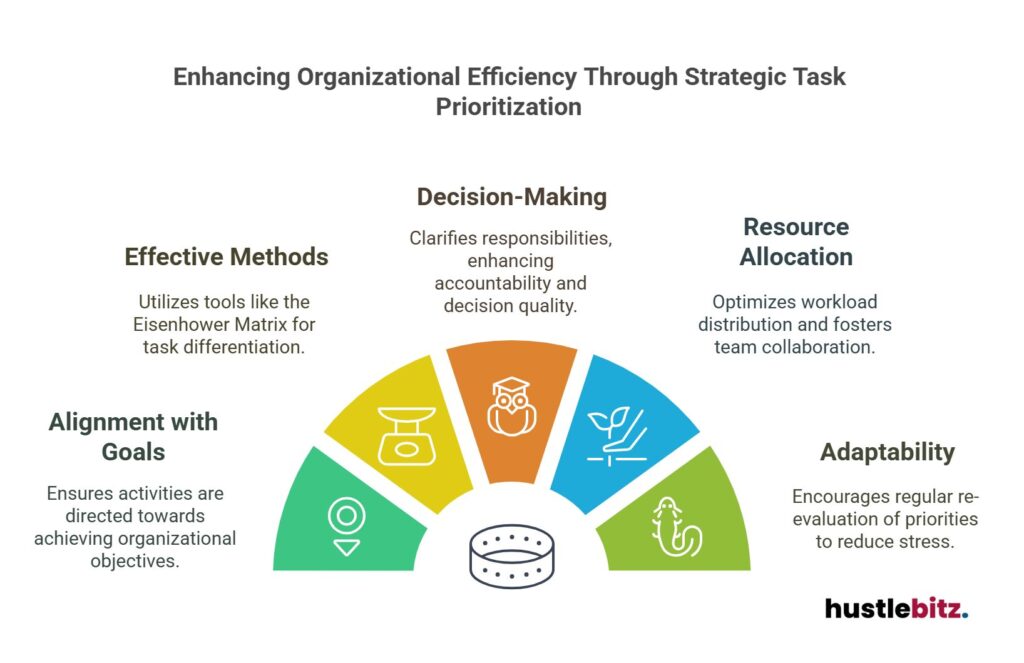Task prioritization is essential for enhancing workplace efficiency. It aligns tasks with organizational goals, enabling teams to focus on impactful activities. By clarifying responsibilities, it increases employee engagement and reduces stress. Effective prioritization techniques, such as the Eisenhower Matrix or Kanban Boards, enhance decision-making and resource allocation. Moreover, balancing urgency and importance ensures critical projects receive the attention they deserve. Understanding common pitfalls, like task overload and unclear goals, can further improve prioritization efforts. By implementing these strategies, organizations can foster a more productive work environment, ultimately leading to greater efficiency and collaboration. Exploring further reveals additional insights on this topic.
Key Takeaways
- Task prioritization aligns activities with organizational goals, enhancing focus and direction for employees.
- Employing methods like the Eisenhower Matrix ensures effective differentiation between urgent and important tasks.
- Improved decision-making processes stem from clear task responsibilities and enhanced accountability.
- Streamlined resource allocation through prioritization optimizes workload distribution and team collaboration.
- Regularly re-evaluating priorities fosters adaptability and reduces stress among team members.

Importance of Task Prioritization in the Workplace
How crucial is task prioritization in enhancing workplace efficiency and productivity?
Task prioritization serves as a foundational element in achieving effective task alignment, enabling teams to focus on the most critical activities that directly contribute to organizational goals. By clearly defining priorities, employees can allocate resources more effectively, ensuring that time and effort are concentrated on tasks that yield the highest impact.
Goal setting becomes significantly more achievable when tasks are prioritized. Employees experience heightened engagement as they understand their roles within the broader context of team objectives. This alignment fosters a sense of ownership and accountability, motivating individuals to meet project deadlines while maintaining high performance metrics.
Moreover, effective task prioritization facilitates improved decision-making processes. When teams collaboratively identify and rank tasks, they can streamline workflows, optimize resources, and mitigate the risks associated with last-minute changes or miscommunication. This collaborative approach not only enhances team dynamics but also contributes to stress reduction among employees, as clarity in task responsibilities diminishes uncertainty.
In a fast-paced work environment, where competing demands are commonplace, prioritizing tasks ensures that critical initiatives are addressed promptly. This strategic focus ultimately leads to enhanced productivity, as teams are empowered to work cohesively towards shared objectives.
How Task Prioritization Impacts Overall Workplace Efficiency

Effective task prioritization significantly enhances overall workplace efficiency by ensuring that teams concentrate their efforts on the most impactful activities. By aligning tasks with organizational goals, teams can achieve greater goal clarity, which is essential for effective decision making. When tasks are prioritized effectively, resource allocation becomes more streamlined, allowing for optimal workload distribution among team members. This not only enhances team collaboration but also fosters a sense of shared purpose and accountability.
A structured approach to task prioritization can also improve project timelines, as teams can focus on high-priority tasks that drive results. The following table illustrates how different aspects of task prioritization contribute to overall efficiency:
| Aspect of Task Prioritization | Impact on Workplace Efficiency |
| Task Alignment | Ensures focus on strategic goals |
| Resource Allocation | Maximizes effective use of resources |
| Team Collaboration | Enhances communication and teamwork |
| Feedback Loops | Facilitates continuous improvement |
Additionally, prioritizing tasks allows for better stakeholder engagement, as teams can provide timely updates and results based on performance metrics. This clarity in progress and alignment with project timelines not only builds trust with stakeholders but also leads to improved outcomes. In summary, effective task prioritization serves as a cornerstone for enhancing workplace efficiency, ultimately leading to increased productivity and organizational success.
Key Techniques for Effective Task Prioritization
Implementing key techniques for effective task prioritization can significantly enhance the benefits gained from structured prioritization, enabling teams to work more efficiently and achieve their objectives with greater precision. Various methods and tools aid in this endeavor, each offering unique advantages.
- Eisenhower Matrix: This tool helps distinguish between urgent and important tasks, guiding decision-making by categorizing tasks into four quadrants.
- Pareto Principle (80/20 Rule): Focus on the 20% of tasks that will yield 80% of the results, allowing teams to allocate resources effectively.
- MoSCoW Method: This approach categorizes tasks into Must, Should, Could, and Won’t, fostering clarity in prioritization and ensuring alignment with project goals.
- Kanban Boards: Visualize tasks and their statuses, facilitating workflow management and promoting accountability within teams.
In addition to these methods, digital tools enhance task prioritization through features like time blocking and mind mapping.
Time blocking allocates specific time slots for tasks, increasing focus and reducing distractions.
Meanwhile, mind mapping aids in brainstorming and organizing thoughts, enabling clearer visibility of task relationships.
Furthermore, effective delegation techniques ensure that tasks are assigned based on team members’ strengths, promoting goal alignment and maximizing productivity.
Balancing Urgency and Importance: A Strategy for Productivity

Balancing urgency and importance is crucial for enhancing productivity, as it enables professionals to focus on tasks that drive meaningful results rather than merely reacting to immediate demands. Striking this balance requires effective decision-making strategies that differentiate between urgent tasks and important projects. By doing so, organizations can improve workload management and optimize time allocation, leading to better goal alignment across teams.
To facilitate this process, productivity hacks can be employed to prioritize tasks based on their urgency and importance. One effective method is the Eisenhower Matrix, which categorizes tasks into four quadrants, allowing teams to focus on what truly matters. Below is a simplified version of this approach:
| Urgent & Important | Not Urgent & Important | Urgent & Not Important |
| Critical projects with impending deadlines | Long-term strategic initiatives | Tasks that can be delegated |
| Immediate client requests | Employee development programs | Routine administrative duties |
| Crisis management | Research and innovation | Interruptions requiring quick responses |
The Role of Task Prioritization in Time Management

Task prioritization serves as a foundational element in time management, enabling professionals to allocate their time and resources to the most impactful activities.
Effectively managing tasks not only enhances productivity but also fosters a sense of control over one’s workflow. By implementing strategic prioritization, individuals can streamline their daily planning and ensure that their efforts align with overarching goals.
To optimize time allocation, consider the following key strategies:
- Utilize a Priority Matrix: Categorize tasks based on urgency and importance to identify what requires immediate attention versus what can be scheduled for later.
- Implement Focus Techniques: Employ methods such as the Pomodoro Technique to maintain concentration on prioritized tasks, allowing for efficient use of time.
- Incorporate Energy Assessment: Recognize your peak productivity times and align high-priority tasks during these periods to maximize output.
- Engage in Task Delegation: Where possible, delegate lower-priority tasks to team members, freeing up time for critical responsibilities that demand your expertise.
Common Pitfalls in Task Prioritization and How to Avoid Them

Ineffective task prioritization can lead to decreased productivity and increased stress, making it essential to recognize and address common pitfalls that hinder effective workflow management. One prevalent issue is task overload, where individuals take on more responsibilities than they can manage, resulting in burnout. Coupled with unclear goals, this can leave employees feeling lost and overwhelmed, impeding their ability to prioritize effectively.
Another barrier is the presence of procrastination habits, which can stem from a reactive mindset. This mindset often leads to last-minute efforts that disrupt established priorities. Additionally, a lack of criteria for assessing tasks can result in emotional decision making, where choices are based on feelings rather than objective evaluations, further complicating prioritization.
Micromanagement issues can also exacerbate these pitfalls, as managers may fail to delegate effectively, leading to insufficient delegation of responsibilities. This not only stifles team members’ growth but also contributes to a sense of multitasking challenges, where individuals juggle multiple tasks without clear direction. Lastly, rigid prioritization can prevent flexibility, making it difficult to adapt to shifting priorities or unexpected challenges.
To avoid these pitfalls, organizations should encourage open communication, establish clear goals, and foster a culture of trust that supports effective delegation.
Final Thoughts
Effective task prioritization is crucial for enhancing workplace efficiency and productivity. By utilizing structured methods like the Eisenhower Matrix, setting clear goals, and balancing urgency with importance, organizations can create an environment where teams focus on tasks that drive meaningful results. Avoiding common pitfalls such as task overload and unclear goals is essential for maintaining a streamlined workflow and reducing stress. When implemented thoughtfully, task prioritization not only optimizes resource allocation but also fosters a culture of collaboration, adaptability, and continuous improvement. Ultimately, prioritizing tasks effectively empowers employees to work more efficiently, contributing to the overall success and growth of the organization.




